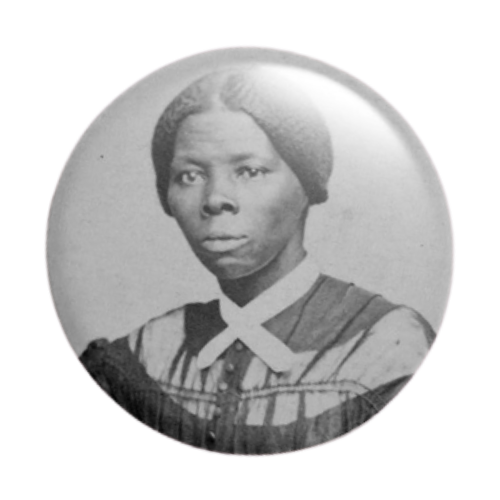TAKE ACTION!
TAKE ACTION!
“When people show up, change happens;
when people don’t show up, nothing changes.”
~ Dr. James Brewer Stewart
If you feel called to address systemic racism in some way, here are ideas:
Support the Overground Railroad Project; wear a Harriet Tubman pin!
Subscribe to our Updates to receive occasional notifications.
Support Organizations that work for racial justice and Businesses that are owned by people of color.
Engage with and support the Rondo Community.
Continue your Education about historical and systemic racism.
And, most importantly, get involved and keep going!
Harriet Tubman: The Hero She Was, The Symbol She Became
Harriet Tubman took action for justice again and again in her life. She became a powerful symbol of resistance against oppression and is a source of inspiration for movements advocating racial justice.
Who was Harriet Tubman of the 19th century Underground Railroad and why is she so important as a symbol for the anti-racism work that Pay Attention! aims to promote?
-
Harriet Tubman is the best known “conductor“ on the Underground Railroad, a network of secret routes, winding through woods and along snake-filled waterways from Southern slave states to Northern free states and Canada. Along these undisclosed trails and routes were privately-held “safe houses“ - abolitionist homes and churches - where run-away slaves could find food, shelter and protection on their journey. Between 1849 and 1860, Tubman made 13 trips to the South, encouraging and cajoling more than 70 enslaved people to follow her north to freedom.
-
To carry out clandestine rescues of her siblings and elderly parents and numerous other enslaved people, Harriet devised clever strategies that helped her forays be successful. Risky endeavors included leaving on a Saturday night, since runaway notices couldn’t be posted in newspapers until Monday morning; appropriating a horse and buggy from the master for the first leg of the journey; using the night sky as a compass, particularly the North star, as she had no maps; turning abruptly south if she heard slave-hunters’ dogs in the distance; and carrying a potion to quiet a crying child who might put the runaways in jeopardy.
-
During the Civil War, Harriet was undaunted in leading a Union Army expedition at the Combahee River in South Carolina where she guided Union soldiers in a raid that liberated more than 700 enslaved people. She is widely credited as being the first woman to lead an armed military operation for the United States Army. Harriet valiantly worked for the Union behind Confederate lines as a nurse and spy during the war.
-
Harriet’s incredible backstory reveals that she was born into Maryland slavery about 1822. Working in the fields as a teenager, she suffered a traumatic head injury while attempting to protect another enslaved person from a violent punishment. The painful symptoms remained the rest of her life. In her late twenties, she heard rumors that she and other slaves were going to be sold further down south. She resolved to run away, setting out alone on foot one night in 1849. On her second escape attempt, she made it to Philadelphia, found work, saved her wages, and plotted her clandestine returns to slave country to lead others to freedom.
-
Harriet was tough and fiercely determined. She carried a gun for protection and to ’buck-up’ her fugitives if they became tired or scared on the long journey, telling them: “Be free or die.“ She proudly told her friend Frederick Douglas that she “never lost a single passenger in all my journeys.“ He, in turn, called her the “bravest person on this continent.“ Harriet became known as “Moses“ to her people.
Harriet Tubman: The Overground Railroad Project
“I was the conductor of the Underground Railroad for eight years, and I can say what most conductors can’t say — I never ran my train off the track and I never lost a passenger.”
~ Harriet Tubman
Jim Stewart originated the idea of a modern Overground Railroad Project to contrast with the metaphorical 19th century Underground Railroad that secretly enabled enslaved people to journey toward freedom. Harriet Tubman is, of course, well known as a fearless “conductor” on the Underground Railroad during the tortuous years leading up to the Civil War. That Underground Railroad lived in the shadows, always fearful of discovery, exposure, the fierce teeth of the slave-catcher’s dog.
By contrast, the Overground Railroad of the 21st century that Jim dreamed of has emerged into the light and is seen by the Pay Attention! Project as a metaphor for the focused and dogged anti-racism work that the Twin Cities and our country desperately need.
For years before Jim Stewart thought of the Overground Railroad metaphor, he was always seen wearing a small Harriet Tubman pin on his shirt or lapel. He was a strong admirer of Harriet, feeling that she symbolized taking action against injustice. Jim claimed that the pin was a conversation-starter wherever he went because it unmistakably identified him as an anti-racist person.
The Harriet Tubman pin has now become associated with the metaphor of the Overground Railroad.
Wearing a Harriet pin clearly demonstrates to the world that the wearer is a justice-seeking person, ready to roll up their sleeves and do what is necessary to promote equality and goodwill in the world.
Acquiring Harriet Tubman Pins
To order Harriet Tubman pins from Pay Attention! for yourself, your family, your church group, your scout troop, your teen center, your student union, your work team, your senior community, etc., contact us at: payattnproject@gmail.com.
The Harriet Tubman Pin: Taking Action Against Injustice


Thank you for taking the time
to take action.


